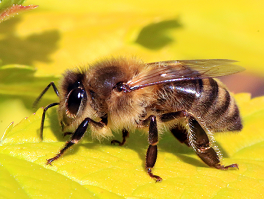Protect Honey Bees When You Use Insecticides Outdoors
By Chris Williams on July 27, 2015.
I’ve been reading about the various concerns and initiatives to help protect honey bees from pesticides. I’m an avid gardener and I try to use natural controls, but occasionally I have to use insecticides to control garden insects. I want to be kind to our honey bees. Are there things I should be doing to help protect them?
F. H., Holden, MA

Western Honey Bee – Apis melifera
Honey bees need everyone’s help since their numbers are still declining for reasons that haven’t been fully explained (see More of Our Bees Are in Trouble). In the pest control business, we are very careful to protect honey bees, and all pollinators, whenever we have to apply insecticides near flowering plants.
Of particular concern is the use of certain neonicotinoid class insecticides which may be one factor in the “colony collapse disorder” affecting honey bees (see In the News – Honey Bee Colony Collapse Disorder). Although neonicotinoids are used primarily in agriculture, many plant growers and plant nurseries use these insecticides to pre-treat plants offered for sale. Some retail plant sellers have stopped selling landscape plants treated with neonicotinoid insecticides.
Precautions When Using Insecticides Near Flowering Plants
As a home gardener, there are steps that you can take when using any insecticide where bees are foraging.
1. When possible, avoid treating foliage or flowers. Instead, limit your treatment around plants to granular applications or to soil treatment around the base of the plant. Consider treating plants with root injection instead of sprays.
2. Avoid applying insecticide on (or near) flowering plants during daylight hours when bees are foraging. Whenever possible, spray at dusk or very early in the morning when bees are not active.
3. Before you treat, study the area for a minute. Do you see any kind of flying insects hovering around the plants? Besides honey bees, various solitary bees, larger bumble bees, and carpenter bees all visit and pollinate flowers. Some plants have very tiny flowers that may not be seen at first glance. Blooming weeds attract pollinators, too.
4. Avoid using insecticide dusts, wettable powders, or any formulation that dries to a powder. Particles can stick to the bees’ body hairs and are then carried back to the hive where they can kill hundreds.
5. Don’t treat if winds are greater than 10 mph or if temperatures are extremely high, use low pressure and a coarse spray, and don’t exceed the rate of application allowed on the label. Always read the insecticide label thoroughly before you treat. Newer pesticide labels now have a bee hazard icon and a bee advisory box with special precautions.
Photo Credit: Charlesjsharp (Own work, from Sharp Photography, sharpphotography) [CC BY-SA 3.0], via Wikimedia Commons